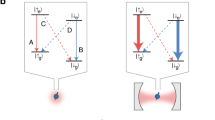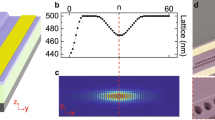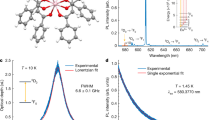Abstract
Distributing entanglement over long distances using optical networks is an intriguing macroscopic quantum phenomenon with applications in quantum systems for advanced computing and secure communication1,2. Building quantum networks requires scalable quantum light–matter interfaces1 based on atoms3, ions4 or other optically addressable qubits. Solid-state emitters5, such as quantum dots and defects in diamond or silicon carbide6,7,8,9,10, have emerged as promising candidates for such interfaces. So far, it has not been possible to scale up these systems, motivating the development of alternative platforms. A central challenge is identifying emitters that exhibit coherent optical and spin transitions while coupled to photonic cavities that enhance the light–matter interaction and channel emission into optical fibres. Rare-earth ions in crystals are known to have highly coherent 4f–4f optical and spin transitions suited to quantum storage and transduction11,12,13,14,15, but only recently have single rare-earth ions been isolated16,17 and coupled to nanocavities18,19. The crucial next steps towards using single rare-earth ions for quantum networks are realizing long spin coherence and single-shot readout in photonic resonators. Here we demonstrate spin initialization, coherent optical and spin manipulation, and high-fidelity single-shot optical readout of the hyperfine spin state of single 171Yb3+ ions coupled to a nanophotonic cavity fabricated in an yttrium orthovanadate host crystal. These ions have optical and spin transitions that are first-order insensitive to magnetic field fluctuations, enabling optical linewidths of less than one megahertz and spin coherence times exceeding thirty milliseconds for cavity-coupled ions, even at temperatures greater than one kelvin. The cavity-enhanced optical emission rate facilitates efficient spin initialization and single-shot readout with conditional fidelity greater than 95 per cent. These results showcase a solid-state platform based on single coherent rare-earth ions for the future quantum internet.
This is a preview of subscription content, access via your institution
Access options
Access Nature and 54 other Nature Portfolio journals
Get Nature+, our best-value online-access subscription
$29.99 / 30 days
cancel any time
Subscribe to this journal
Receive 51 print issues and online access
$199.00 per year
only $3.90 per issue
Buy this article
- Purchase on Springer Link
- Instant access to full article PDF
Prices may be subject to local taxes which are calculated during checkout




Similar content being viewed by others
Data availability
The data that support the findings of this study are available from the corresponding author upon request.
References
Kimble, H. J. The quantum internet. Nature 453, 1023–1030 (2008).
Wehner, S., Elkouss, D. & Hanson, R. Quantum internet: a vision for the road ahead. Science 362, eaam9288 (2018).
Reiserer, A. & Rempe, G. Cavity-based quantum networks with single atoms and optical photons. Rev. Mod. Phys. 87, 1379–1418 (2015).
Duan, L. M. & Monroe, C. Colloquium: quantum networks with trapped ions. Rev. Mod. Phys. 82, 1209–1224 (2010).
Awschalom, D. D., Hanson, R., Wrachtrup, J. & Zhou, B. B. Quantum technologies with optically interfaced solid-state spins. Nat. Photon. 12, 516–527 (2018).
Hensen, B. et al. Loophole-free Bell inequality violation using electron spins separated by 1.3 kilometres. Nature 526, 682–686 (2015).
Koehl, W. F., Buckley, B. B., Heremans, F. J., Calusine, G. & Awschalom, D. D. Room temperature coherent control of defect spin qubits in silicon carbide. Nature 479, 84–87 (2011).
Sun, S., Kim, H., Luo, Z., Solomon, G. S. & Waks, E. A single-photon switch and transistor enabled by a solid-state quantum memory. Science 361, 57–60 (2018).
Sipahigil, A. et al. An integrated diamond nanophotonics platform for quantum-optical networks. Science 354, 847–850 (2016).
Nguyen, C. T. et al. Quantum network nodes based on diamond qubits with an efficient nanophotonic interface. Phys. Rev. Lett. 123, 183602 (2019).
Zhong, M. et al. Optically addressable nuclear spins in a solid with a six-hour coherence time. Nature 517, 177–180 (2015).
Ortu, A. et al. Simultaneous coherence enhancement of optical and microwave transitions in solid-state electronic spins. Nat. Mater. 17, 671–675 (2018).
Hedges, M. P., Longdell, J. J., Li, Y. & Sellars, M. J. Efficient quantum memory for light. Nature 465, 1052–1056 (2010).
Williamson, L. A., Chen, Y.-H. & Longdell, J. J. Magneto-optic modulator with unit quantum efficiency. Phys. Rev. Lett. 113, 203601 (2014).
Kutluer, K. et al. Time entanglement between a photon and a spin wave in a multimode solid-state quantum memory. Phys. Rev. Lett. 123, 030501 (2019).
Kolesov, R. et al. Optical detection of a single rare-earth ion in a crystal. Nat. Commun. 3, 1029 (2012).
Utikal, T. et al. Spectroscopic detection and state preparation of a single praseodymium ion in a crystal. Nat. Commun. 5, 3627 (2014).
Zhong, T. et al. Optically addressing single rare-earth ions in a nanophotonic cavity. Phys. Rev. Lett. 121, 183603 (2018).
Dibos, A. M., Raha, M., Phenicie, C. M. & Thompson, J. D. Atomic source of single photons in the telecom band. Phys. Rev. Lett. 120, 243601 (2018).
Kindem, J. M. et al. Characterization of 171Yb3+:YVO4 for photonic quantum technologies. Phys. Rev. B 80, 1–10 (2018).
Businger, M. et al. Optical spin-wave storage in a solid-state hybridized electron–nuclear spin ensemble. Phys. Rev. Lett. 124, 053606 (2020)
Purcell, E. M. Spontaneous emission probabilities at radio frequencies. Phys. Rev. 69, 681 (1946).
Suter, D. & Álvarez, G. A. Colloquium: protecting quantum information against environmental noise. Rev. Mod. Phys. 88, 041001 (2016).
de Lange, G., Wang, Z., Riste, S., Dobrovitski, V. V. & Hanson, R. Universal dynamical decoupling of a single solid-state spin from a spin bath. Science 330, 60–63 (2010).
Klauder, J. R. & Anderson, P. W. Spectral diffusion decay in spin resonance experiments. Phys. Rev. 125, 912–932 (1961).
Abobeih, M. H. et al. One-second coherence for a single electron spin coupled to a multi-qubit nuclear-spin environment. Nat. Commun. 9, 2552 (2018).
Humphreys, P. C. et al. Deterministic delivery of remote entanglement on a quantum network. Nature 558, 268–273 (2018); correction 562, E2 (2018).
Welinski, S. et al. Coherence time extension by large scale optical spin polarization in a rare-earth doped crystal. Preprint at https://arxiv.org/abs/1910.07907 (2019).
Bernien, H. et al. Heralded entanglement between solid-state qubits separated by three metres. Nature 497, 86–90 (2013).
Zhong, M., Ahlefeldt, R. L. & Sellars, M. J. Quantum information processing using frozen core Y3+ spins in Eu3+:Y2SiO5. New J. Phys. 21, 033019 (2019).
Zhong, T. et al. Nanophotonic rare-earth quantum memory with optically controlled retrieval. Science 357, 1392–1395 (2017).
Bartholomew, J. G. et al. On-chip coherent microwave-to-optical transduction mediated by ytterbium in YVO4. Preprint at http://arxiv.org/abs/1912.03671 (2019).
Raha, M. et al. Optical quantum nondemolition measurement of a solid-state spin without a cycling transition. Preprint at http://arxiv.org/abs/1907.09992 (2019).
Zhong, T., Rochman, J., Kindem, J. M., Miyazono, E. & Faraon, A. High quality factor nanophotonic resonators in bulk rare-earth doped crystals. Opt. Express 24, 536–544 (2016).
Acknowledgements
This work was funded by a National Science Foundation (NSF) Faculty Early Career Development Program (CAREER) award (1454607), the AFOSR Quantum Transduction Multidisciplinary University Research Initiative (FA9550-15-1-0029), NSF 1820790, and the Institute of Quantum Information and Matter, an NSF Physics Frontiers Center (PHY-1733907) with support from the Moore Foundation. The device nanofabrication was performed in the Kavli Nanoscience Institute at the California Institute of Technology. J.G.B. acknowledges the support from the American Australian Association’s Northrop Grumman Fellowship. J.R. acknowledges the support from the Natural Sciences and Engineering Research Council of Canada (NSERC) (PGSD3-502844-2017). Y.Q.H. acknowledges the support from the Agency for Science, Technology and Research (A*STAR) and Carl & Shirley Larson as a Frederick W. Drury Jr. SURF Fellow. We thank M. Shaw, S. Woo Nam and V. Verma for help with superconducting photon detectors; A. Sipahigil for discussion; K. Schwab for help with electronics; and D. Riedel for supporting measurements.
Author information
Authors and Affiliations
Contributions
J.M.K., J.G.B. and A.F. conceived the experiments. J.R. fabricated the nanophotonic device. J.M.K., A.R. and J.G.B. performed the experiments and analysed the data. Y.Q.H. provided simulation support. J.M.K., A.R. and A.F. wrote the manuscript with input from all authors. A.F. supervised the project.
Corresponding author
Ethics declarations
Competing interests
The authors declare no competing interests.
Additional information
Peer review information Nature thanks David Hunger, Andreas Reiserer and the other, anonymous, reviewer(s) for their contribution to the peer review of this work.
Publisher’s note Springer Nature remains neutral with regard to jurisdictional claims in published maps and institutional affiliations.
Extended data figures and tables
Extended Data Fig. 1 Extended PLE scans and expected ion distribution.
a, Photoluminescence scan over 12 GHz centred around the optical transition of the zero-nuclear-spin isotope with zero applied magnetic field. The dashed box highlights the region scanned in Fig. 2a. b, Predicted optical transition frequencies of the different Yb isotopes for \(E\parallel c\,\) with transition strength scaled to natural abundance.
Extended Data Fig. 2 Spin initialization.
Blue (red) scans correspond to preparation into the \({|0\rangle }_{{\rm{g}}}\) (\({|1\rangle }_{{\rm{g}}}\)) state. a, Initialization into qubit subspace. The number of preparation pulses on the A and fe transitions is held fixed at 100 while the number of preparation pulses on transition F is varied. b, Initialization within qubit subspace. The number of preparation pulses on F is held fixed at 150 while the number of preparation pulses on transitions A and fe is varied. The observed population contrast corresponds to an initialization fidelity of >96% within the qubit subspace.
Extended Data Fig. 3 Additional optical coherence measurements.
a, Measurement of optical T2 on ion Y using an echo sequence. The fit gives T2 = 4.1 ± 0.2 μs. b, Post-selected optical Ramsey measurement (Supplementary Section 4) with resonant excitation showing improvement in \({T}_{2}^{* }\) for increasing numbers of photons nc detected in a subsequent probe sequence. c, Post-selected Ramsey sequence for nc = 2 with readout detuned by 1 MHz to demonstrate that decay is due to optical coherence.
Extended Data Fig. 4 Additional CPMG measurements.
a, Scaling of coherence time extracted from CPMG envelope (Fig. 3c) for increasing numbers of rephasing pulses. Error bars represent 68% confidence intervals for CPMG coherence times. The fit gives \({T}_{2,{\rm{s}}\,}^{N}\propto {N}^{0.70\pm 0.01}\). b, Fine-resolution CPMG scans performed with N = 1 (red) and N = 8 (blue) rephasing pulses showing periodic collapses and revivals of the spin coherence. The N = 1 scan is offset by 500 counts for clarity.
Extended Data Fig. 5 Spin lifetime measurements.
a, Measurement of population in the \({|0\rangle }_{{\rm{g}}}\) and \({|1\rangle }_{{\rm{g}}}\) states after initializing into the \({|0\rangle }_{{\rm{g}}}\) state and waiting for time τ. Exponential fit gives a lifetime of 54 ± 5 ms. The measured population difference corresponds to a device temperature of 59 ± 4 mK. b, Slow decay of population from qubit subspace into the \({|{\rm{aux}}\rangle }_{{\rm{g}}}\) state with decay constant 26 ± 2 s.
Supplementary information
Supplementary Information
This file contains Supplementary Text 1-6 and Supplementary Figures S1-S10.
Rights and permissions
About this article
Cite this article
Kindem, J.M., Ruskuc, A., Bartholomew, J.G. et al. Control and single-shot readout of an ion embedded in a nanophotonic cavity. Nature 580, 201–204 (2020). https://doi.org/10.1038/s41586-020-2160-9
Received:
Accepted:
Published:
Issue Date:
DOI: https://doi.org/10.1038/s41586-020-2160-9
This article is cited by
-
Emergence of highly coherent two-level systems in a noisy and dense quantum network
Nature Physics (2024)
-
Engineering colloidal semiconductor nanocrystals for quantum information processing
Nature Nanotechnology (2024)
-
Progress in quantum teleportation
Nature Reviews Physics (2023)
-
Single-electron spin resonance detection by microwave photon counting
Nature (2023)
-
Quantum networks with neutral atom processing nodes
npj Quantum Information (2023)
Comments
By submitting a comment you agree to abide by our Terms and Community Guidelines. If you find something abusive or that does not comply with our terms or guidelines please flag it as inappropriate.



